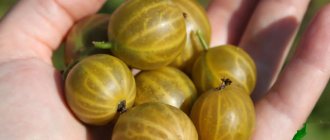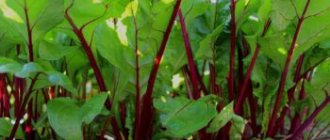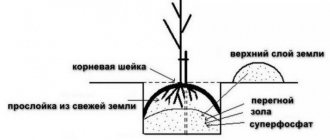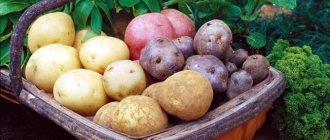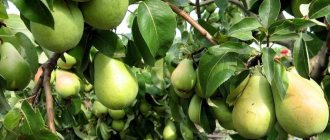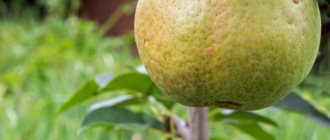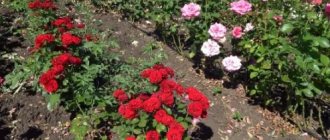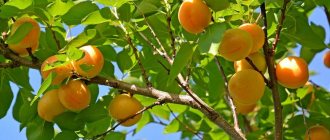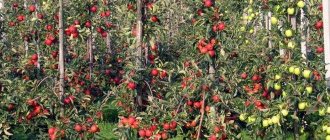Hello!
The Moscow region differs from the rest of Central Russia in weather only in that it has more unpredictable winters; This does not affect the cultivation of pepper in any way, and the principles of agricultural technology are the same as in other areas of the middle zone.
Breeders have worked hard to create varieties of sweet Bulgarian that will be adapted to various temperature fluctuations, and also did not forget to work a little to ensure that the color of such a vegetable was very diverse: yellow, dark red, green, purple. The shape of this sweet vegetable is also varied: large, cone-shaped, small, tomato-like, pyramidal and others.
Features of choosing greenhouse varieties
For sale and long-term storage, choose varieties with thick and elastic walls . When choosing a variety for further canning, preference is given to small peppers weighing no more than 70 g.
Plant care plays an important role : some crops are unpretentious - it is enough to follow the regime of watering and fertilizing, others require increased attention - to get a rich harvest you need to shape, tie up and pinion the bush.
Important! The choice of variety is influenced by the plant’s resistance to insect pests and diseases. The greenhouse is characterized by high humidity and stuffiness, so it is recommended to sow varieties with strong immunity to infections and pests.
Benefits of growing peppers in a greenhouse
- You don't have to worry about changing weather conditions.
- The seedlings take root well due to the optimal microclimate in the soil.
- Bushes are less susceptible to diseases and insect attacks.
- Longer fruiting and shorter fruit ripening period.
The only disadvantages include limited space. That's why
Important! Breeders have developed low-growing varieties of peppers with compact bushes that take up little space in a greenhouse.
The best varieties for the Moscow region
Let's consider common varieties that show the best yield in regions with a temperate climate in greenhouse conditions.
Alyonushka
Pepper is mid-season, gives the first harvest 120 days after the appearance of the first shoots . Hybrid Alyonushka has semi-spreading bushes up to 1.5 m high. The leaves are large, rich green. The fruits are prismatic, slightly elongated. The wall thickness is 5 mm, so Alyonushka is not suitable for long-term storage.
The weight of the fruit varies from 100 to 130 g, the hybrid is distinguished by its juicy and sugary pulp and sweet taste. The vegetable is resistant to late blight and tobacco mosaic virus. Shows stable yield - about 8 kg per 1 m².
California miracle
The California Miracle variety has an average ripening time , about 115 days from the appearance of the first shoots. The bushes are low, about 75 cm in height. The shape is cuboidal, flattened, slight ribbing is visible. The peel is dense and smooth, up to 8 mm thick. The color is rich red, the taste and aroma are sweet.
Pepper "California Miracle"
Fruit weight is about 100 g, length is 10-12 cm. Productivity is about 10 kg per 1 m². The California Miracle variety is universal in application - it is used for pickling and canning, preparing salads and side dishes, appetizers and soups.
Important! To obtain an earlier harvest, bell peppers are planted in seedlings. Seedlings strengthen the plant's immunity, protect against diseases and pests. Before planting, the soil in the greenhouse is treated and the walls and doors are wiped with disinfectants. During the growing process, greenhouses are ventilated daily.
ox ear
Neat bushes reach a height of no more than 70 cm . Ox's ear matures within 120 days from planting. The shape of the fruit is cone-shaped, the length reaches 12 cm. The average weight of the vegetable is 200 g, the wall thickness is 7-8 mm. The color is rich red, the flesh is fleshy and juicy. With proper storage organization, Ox Ear can be stored for up to 3 months and retains its marketability and taste.
The variety is easy to care for and resistant to insect pests and viral diseases. An experienced gardener and a novice gardener can get a rich harvest.
Pepper "Ox's Ear"
Bagration
Early ripening Bagration is grown not only in greenhouses, but also in open ground . Pepper is characterized by rapid fruit set and extended fruiting. Plant height is up to 1 m, the root system is powerful and developed. The fruits are cube-shaped, flattened, with thick walls.
During maturity, the vegetable acquires an orange color with a yellow or red tint. Thanks to its attractive appearance, Bagration looks appetizing in sliced vegetables or as winter preparations. Pepper weight is up to 200 g, 13-15 ripe glossy fruits are collected from 1 bush.
Pepper "Bagration"
Orange King
Orange King is a juicy variety with excellent taste . The pulp is sugary, sweet and tender. The plant does not require special skills to care for, the height of the bush is up to 1 m, the leaves are medium in size. Planted with seedlings or seeds. Vegetable weight up to 160 g, wall thickness 6 mm. The surface is ribbed, attractive orange.
Orange king is used fresh and for preparing healthy vegetable dishes. The yield of the variety is 4 kg per 1 m².
Important! The pulp of bell pepper contains vitamins A, E, C, essential for humans, as well as trace elements, acids and dietary fiber. Eating vegetables improves intestinal health, eliminates inflammatory processes and strengthens the immune system. After heat treatment, peppers retain most of their beneficial properties.
Pepper "Orange King"
Bagheera
The mid-season variety of bell pepper ripens 110-115 days after the appearance of the first shoots. The bushes are compact, up to 50 cm in height. The fruits are glossy, purple with a red tint. Weight from 150 to 300 g, walls about 8 mm thick.
Among the advantages of the variety are::
- sweet and juicy taste;
- original appearance;
- high yield - up to 4 kg per 1 m²;
- resistance to diseases and pests.
Pepper "Bagheera"
Night
Hybrid Nochka is planted on nutritious and loose soils . Pepper ripens in 130-140 days, the height of the bushes reaches 1 m. The plant is semi-spreading, the foliage is average. The fruits are cube-shaped, purple-red in color. Wall thickness 6-8 mm, pepper weight up to 150 g.
The pulp is sweet, the aroma is pleasant, strongly pronounced. Gardeners harvest up to 4 kg of harvest from 1 plant. The hybrid is universal in use, suitable for long-term storage and use immediately after collection.
Hybrid "Night"
Golden calf
The variety is suitable for long-term storage, the wall thickness reaches 10 mm . The Golden Calf matures in 100-110 days from the moment of planting and is distinguished by its attractive appearance and resistance to diseases and pests. Plant height is 1 m, fruit weight is 200-300 g. The peel is glossy, bright orange in color. Bell peppers are high in vitamins and are suitable for preparing low-calorie dietary dishes.
Pepper "Golden Calf"
Pinocchio
Pinocchio hybrid shows the best yield in regions with warm and temperate climates . Recommended for planting seedlings. Ripens in 90-100 days from the moment the first shoots appear. The plant reaches a height of 80 cm and is unpretentious in care. The fruits set together, the average weight of the pepper is 120 g.
The length of the fruit is up to 15 cm, width 8 cm. The surface is smooth, the color is red. The shape is cone-shaped, the wall thickness is 5-6 mm. Up to 10 fruits are collected from 1 plant. Pinocchio is resistant to root rot and tobacco mosaic virus.
Hybrid "Pinocchio"
Hercules
The fertile and high-yielding Hercules is planted as seedlings . Plant height up to 50 cm, leaves large, dark green. The fruits are cube-shaped, with a thick red skin. Pepper weight is 200-300 g. Hercules is suitable for long-term transportation, stored for 2-3 months. The vegetable has a classic sweet taste and a pleasant aroma. Up to 4 kg are collected from 1 m². Bell pepper Hercules is consumed fresh, frozen and canned for the winter.
Pepper "Hercules"
Technology for picking pepper seedlings
- You need to compact the soil in the container, make a hole in the center for the plant and pour water into it;
- Using a spoon, carefully remove the pepper seedling from the box. Choose the healthiest and strongest sprouts;
- The seedling is placed in the hole so that the roots are freely located in it. If the lateral roots have not formed, then it is necessary to pinch the central root. In this case, you need to maintain the same planting depth as before picking. Otherwise, the stem may rot;
- The hole is carefully covered with earth and watered;
- A glass with a pepper seedling is placed in a common container.
Advice! A simple trick will help prevent the plant's roots from bending in the ground. The seedling is immersed in the soil a little deeper, and after sprinkling with earth, it is pulled out to the desired level. So, the roots will take a natural position.
The first days after picking, the plants should be left in the same place where they were sown. Then the adaptation process for pepper will be quick and painless. After 10 days, the seedlings need to be fed with the mixture that was prepared in the greenhouse in the fall. Before and after fertilizing, pepper sprouts should be watered generously. You can fertilize with mineral fertilizers or a growth stimulator. 1 g of potassium permanganate, 2 g of copper sulfate and 1-2 g of boric acid are diluted in 10 liters of water. The solution should sit for at least a day, after which you can water the sprouts.
Transplanting seedlings into a greenhouse
5-7 days after picking, pepper seedlings need to be prepared for greenhouse conditions. During the daytime, the box with plants is taken out to the greenhouse. During this time, the sprouts will get stronger, 10-12 leaves will form, new buds will appear in the axils, and it will be possible to begin replanting.
Remove the film from the area intended for planting pepper and dig up the ground. You need to make a bed 50-55 cm wide and water it with a fertilizing mixture three days before planting the seedlings. To prevent soil from falling off the edges of the bed, you can make wooden sides. This will eliminate the need to hill up plants in the greenhouse and make caring for the crop easier. Such a bed will keep its shape well and ensure uniform distribution of water when watering plants.
It is best to transplant plants in the evening, at night. On the morning of planting, seedlings are watered abundantly.
Technology of planting seedlings in the garden
- A hole is made in the garden using a hoe. Its depth should correspond to the height of the pot with the seedling.
- You need to pour water into the hole.
- The seedling is carefully removed along with a lump of earth, then moved into a recess in the garden bed and sprinkled with earth.
- The soil around the sprout needs to be compacted and watered.
Greenhouse varieties of pepper are tolerant of a lack of sunlight. But excessive shading can cause the plant to wither. Therefore, it is better not to plant tall or climbing crops next to pepper in a greenhouse. When choosing “neighbors” for bell peppers, keep in mind that their height should be lower. You can plant greens or root vegetables in close proximity to the pepper bed.
Watering peppers in a greenhouse
During the first 10 days in the greenhouse, pepper seedlings are watered under the root. During this time, they will take root well and new leaves will appear. Now you can feed the plants.
On the 10th day after transplanting the pepper, the soil around the stem is carefully loosened and a feeding solution is poured. This procedure is repeated as soon as the plant blooms.
The best varieties for the Moscow region for open ground
For open ground, varieties and hybrids are chosen that are distinguished by early ripening.
We recommend paying attention to the following crops:
- Barguzin . Cone-shaped fruits ripen in 80-90 days from planting. They adapt to external climatic conditions and show stable yields. The variety is unpretentious in care; it is planted by seedlings or seeds in open ground. It is resistant to viruses and insect pests. The color is yellow, the height of the fruit is about 150 g, the wall thickness is 6 mm. 12-15 bright peppers are collected from 1 plant.
- Cornet . The drooping prism-shaped fruits are red-brown in color. Weight from 150 to 200 g, taste sweet, flesh dense. The height of the plant is about 1 m; to obtain the greatest harvest, staking and bush formation are required. Cornet is distinguished by extended fruiting and high yield - about 3 kg per 1 m².
- Nafanya (pictured). The height of the plant is about 80 cm, the leaves are large. Planted on sunny and loose soils with a neutral acidity level. The wall thickness is 7 mm, Nafanya is universal in use. The pepper weighs about 150 g, the color is rich red. It is resistant to viral and fungal diseases. One bush produces 8-12 fruits.
- Big Mama. The versatile variety is grown in greenhouses and outdoors. The bushes reach a height of 1 m, semi-spreading. The weight of the pepper is about 200 g, the color is glossy orange. The walls of the fruit are 10-13 mm, the crop is excellent for long-term storage in the basement or cellar.
- Merchant. An early ripening variety produces the first fruits after 90-100 days. The vegetable is planted on loamy or sandy loam soils. The shape is prism-shaped, the color is red. The pulp is sweet and juicy and has a high content of vitamins A and C. The weight of the pepper reaches 130 g, the harvested crop is used for preparing winter preparations, for fresh consumption and for freezing.
When to plant and harvest in the Moscow region
Since summer in the Moscow region is short, when choosing a variety it is better to give preference to early pepper. Considering that the seeds germinate in approximately 7-9 days, and the seedlings are planted in the garden at the age of 65 days, therefore, the seeds should be sown in the second ten days of March.
Please note: when purchasing seeds, give preference to zoned varieties, that is, those peppers that are bred specifically for the climate of a particular area, are resistant to local diseases, and are able to grow in a certain type of soil. All this information can be read on the seed label. Or visit the State Register website, which contains all the accurate information about the available varieties of bell pepper.
To successfully cultivate crops in unprotected soil, the soil under the beds must be well fertilized. It must contain organic matter, as well as potassium and phosphorus elements. If planting was carried out in open ground, then the first half of June should be kept under temporary film covers.
If mid-season varieties were planted, then you should not wait for the peppers on the bush to fully ripen, otherwise you may lose a significant part of the harvest due to sudden frosts. Bell peppers ripen well indoors. The main thing is to store peppers in a dry, cool and dark place. At the same time, peppers should be removed from the bush with the stalk.
Advice: for the Moscow region it is better to choose varieties that are not so productive, but are guaranteed to produce a harvest.
If you want to prolong fruiting, then you should regularly remove vegetables from the bush. This will stimulate the appearance of new ovaries.
Reviews
Let's look at a few reviews from experienced gardeners from Moscow and the Moscow region and find out which varieties they prefer:
Polina, Moscow : “For the third season in a row I have been growing the Buratino variety in a polycarbonate greenhouse. I like the unusual elongated shape of peppers and their sweet taste. I use some of it for preparing canned snacks and lecho, and I freeze some of it, after cutting it into cubes. The taste does not deteriorate and remains juicy and sweet.”
Ekaterina, Obninsk : “I love the thick-walled variety Golden Calf. The plant is not picky in its care; during the growing period I feed it with manure and water it. I grow it in a greenhouse. I store the harvest in the basement with a humidity of no more than 80%. The fruits retain their taste and bright color.”
Vyacheslav, Kolomna : “Last year I planted the Kupets variety. The harvest turned out to be small, and I didn’t like the taste, it was too bland. This year Hercules planted peppers and was pleased with the results. The fruits are strong, with thick skin. The taste is sweet and juicy, I recommend it for planting.”
The best varieties of purple Bulgarian vegetable for Siberia
Nowadays, a great variety of bell pepper varieties have appeared, whose color is purple. This is due to the high content of anthocyanin in the product. This substance has a positive effect on human immunity.
The high percentage of anthocyanin in pepper guarantees its good vitality due to the fact that this substance helps the vegetable absorb solar energy and convert it into heat. This substance is useful for humans in that it has a beneficial effect on eye health and can also get rid of dangerous bacteria.
Arab
The favorite among the varieties with a purple color of the vegetable is “Arap”. The peel of the vegetable is so strong that it can be stored longer, it is juicy and tasty and is perfect for cooking. “Arap” is a varietal vegetable, unlike the next representative.
Maxim F1
“Maxim F1” is a hybrid. Of course, this variety of bell pepper has its own advantages, the main one of which is productivity, and does not hide them. This vegetable bears fruit well and is perfectly adapted to the conditions of the Siberian summer , when the temperature difference in a couple of days can reach thirty degrees Celsius.
Growing seedlings
In the Moscow region, obtaining any variety of pepper is possible only by first growing seedlings. If you plan to plant seedlings directly into the ground by transferring them from a seedling pot, the seeds are sown 50 days before planting. If there is picking in the plans, sowing is carried out 60 days in advance.
Preparing for sowing
First, you need to select high-quality seeds so as not to waste resources in the form of soil and containers. The seeds are immersed in slightly salted water. A seed with a fully filled kernel will drown, while an empty one will remain floating. We catch and throw away the empty ones, collect the good ones, wash and dry them.
Important! The likelihood of seedling diseases will be reduced if the seed is treated for 10 minutes in a strong solution of potassium permanganate before planting.
You can speed up the germination of seeds by first placing them in a moist, warm environment. The pepper seeds are pre-soaked for 5-6 hours. Some people prefer to soak the seeds in a stimulant for 3-4 days, since pepper seeds take a long time to germinate.
The most common methods of germination: in a bag and on a saucer.
In a bag
The seeds are soaked directly in a canvas bag. After soaking, the bag is removed and put in a warm place with a temperature of about +27°C. In a few days the seeds will germinate. Some disadvantage of this method is that if you have several varieties of pepper, you will have to make several bags and somehow mark them, since all varieties of pepper are planted for seedlings at the same time.
On a saucer
Any container with a flat bottom can play the role of a saucer. Place a napkin on the bottom, moisten it with water and lay out the seeds. Cover the top with another damp cloth. If the container is closed with a lid, then you do not have to maintain the moisture of the napkin.
Attention! The napkins should be damp at all times, but not “float” in the water.
If there are several varieties of pepper, a dry napkin can be divided into sectors with a ballpoint pen, signing the variety in each sector. This way, instead of labor-intensively making several bags, you can only spend five minutes marking the napkin. The main thing is then to correctly arrange the varieties into their compartments.
In the sponges
If you don’t have a suitable container and don’t want to make bags, you can use regular foam sponges for washing dishes. Of course, the sponges must be clean.
First, the sponges are disinfected in a solution of potassium permanganate, after which they are thoroughly wrung out. Each variety will require two sponges.
The seeds are placed between the sponges, the edges are secured with rubber bands and the sponges are placed in a plastic bag, making sure that there is an air bubble left in the bag.
No one has ever been able to manually squeeze a piece of foam dry, so you don’t have to worry about the presence of water, you just need to turn the sponges over periodically. Water in the foam flows down.
